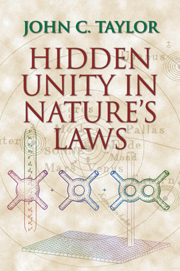Book contents
- Frontmatter
- Contents
- Preface
- 1 Motion on Earth and in the Heavens
- 2 Energy, Heat and Chance
- 3 Electricity and Magnetism
- 4 Light
- 5 Space and Time
- 6 Least Action
- 7 Gravitation and Curved Spacetime
- 8 The Quantum Revolution
- 9 Quantum Theory with Special Relativity
- 10 Order Breaks Symmetry
- 11 Quarks and What Holds Them Together
- 12 Unifying Weak Forces with QED
- 13 Gravitation Plus Quantum Theory – Stars and Black Holes
- 14 Particles, Symmetries and the Universe
- 15 Queries
- APPENDIX A The Inverse-Square Law
- APPENDIX B Vectors and Complex Numbers
- APPENDIX C Brownian Motion
- APPENDIX D Units
- Glossary
- Bibliography
- Index
15 - Queries
Published online by Cambridge University Press: 20 January 2010
- Frontmatter
- Contents
- Preface
- 1 Motion on Earth and in the Heavens
- 2 Energy, Heat and Chance
- 3 Electricity and Magnetism
- 4 Light
- 5 Space and Time
- 6 Least Action
- 7 Gravitation and Curved Spacetime
- 8 The Quantum Revolution
- 9 Quantum Theory with Special Relativity
- 10 Order Breaks Symmetry
- 11 Quarks and What Holds Them Together
- 12 Unifying Weak Forces with QED
- 13 Gravitation Plus Quantum Theory – Stars and Black Holes
- 14 Particles, Symmetries and the Universe
- 15 Queries
- APPENDIX A The Inverse-Square Law
- APPENDIX B Vectors and Complex Numbers
- APPENDIX C Brownian Motion
- APPENDIX D Units
- Glossary
- Bibliography
- Index
Summary
Newton's Principia is written (in Latin) in a lofty, austere way, as if to allow the reader no opportunity to disagree. The Opticks published (in English) 17 years later is more human. It ends with several Queries, in which Newton speculates, without claiming certitude.
I have ventured to borrow Newton's word as the title of this chapter. It is meant to be a warning to the reader that I am now venturing off the fairly well-beaten track followed in the preceding 14 chapters. The speculations that follow are not mine, of course. I have chosen ideas that seem to me to have attracted the attention of the greatest numbers of physicists. I don't suppose any of them is exactly right as it stands. Some may be completely wrong. But I hope that some of them have some truth in them. Only time, and experiment, will tell.
Hidden Dimensions: Charge as Geometry
I begin with a speculation that is almost certainly wrong. My excuses are that it is very pretty and that string theory (Section 15.3) makes use of some of the same ideas.
Around 1915, there seemed to be two beautiful theories: Maxwell's electromagnetism and Einstein's gravity. An obvious dream would be to try to unify them and, in the process, perhaps to find a geometrical basis for electromagnetism similar to Einstein's geometrical theory of gravity. With hindsight, we now know this vision to have been a mirage, because electromagnetism is only a part of the electroweak forces, but even so let us look at one intriguing idea that came up in those days.
- Type
- Chapter
- Information
- Hidden Unity in Nature's Laws , pp. 410 - 430Publisher: Cambridge University PressPrint publication year: 2001



